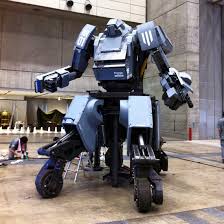Top 10 Robots in the world
Top 10 robots in the world
Nao
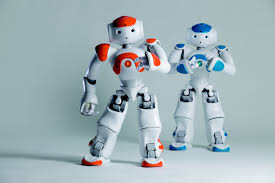
Nao is an autonomous, programmable humanoid robot developed by Aldebran Robotics. The launch of Project Nao began in 2004.The Nao was used in RoboCup 2008 and 2009, and the NaoV3R was chosen as the platform for the SPL at RoboCup 2010. Nao was released to institutions in 2008, and was made publicly available by 2011.
Developed for:
Universities
Laboratories for research and
Education purposes
Specifications:
Height : 58cms
Weight : 4.3kgs
Power supply : Lithium battery 48.6wh
CPU : Intel Atom @1.6GHz
Compatible OS : windows, Mac, Linux
Connectivity : Ethernet, Wi-Fi
Nao have been used for research and education purposes in numerous academic institutions worldwide. As of 2015, over 5,000 Nao units are in use in 50+ countries.
ASIMO

Advanced Step in Innovative Mobility (ASIMO) is a humanoid robot developed by Honda. Introduced on 21 October 2000. ASIMO was designed to operate in real-world environments, with the ability to walk or run on two feet at speeds of up to 6 kilometres per hour.
Developed for:
To encourage study of science and
Mathematics
Specifications:
Height : 130cm
Weight : 54kg
Power supply : lithium ion 51.8v
Languages known : English & Japanese
ASIMO also conducted the Orchestra, dance in Disneyland, etc.
ATLAS

The American robotics company Boston Dynamics introduced this ATLAS humanoid robot, with funding and oversight from the DARPA (United States Defence Advanced Research Projects Agency). This robot was unveiled to the public on July 11, 2013.
Designed for:
Variety of search and rescue tasks
Specifications:
Height : 188cm
Weight : 150kg
Power supply : lithium-ion 3.7 kilowatt
CPU : 3.1-3.3GHz Intel i7
Atlas is intended to aid emergency services in search and rescue operations, performing tasks such as shutting off valves, opening doors and operating powered equipment in environments where humans could not survive.
Pepper

Pepper is a humanoid robot by Aldebaran Robotics and Softbank Mobile designed with the ability to read emotions. Pepper was introduced on 5 June 2014, and has been showcased since 6 June 2014.Mainly pepper is not for domestic use.
Designed for:
To analyse expressions and voice notes
Specifications:
Height : 120cms
Weight : 28kgs
Power supply : Lithium ion30.0Ah/795Wh
Connectivity : Wi-Fi, Ethernet
Pepper is intended to make people happy, enhance people’s lives, facilitate relationships, have fun with people and connect people with the outside world.
HUBO 2 Plus
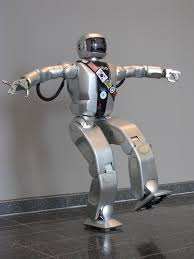
HUBO is a walking humanoid robot, head mounted on a life-size walking bipedal frame, developed by the Korea Advanced Institute of Science and Technology (KAIST) and released on January 6, 2005. Hubo has voice recognition and synthesis faculties, as well as sophisticated vision in which its two eyes move independently of one another.
The robot version can make expressive gestures with its 5 separate fingers.
Specifications:
Height : 130cms
Weight : 43kg
Power supply : Lithium ion24v
Compatible Os : Debian Linux, windows
A HUBO was the winner of the DARPA Robotics Challenge finals on June 6, 2015.
HOVIS
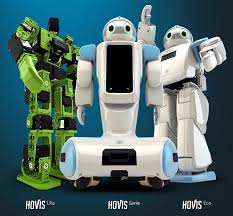
Hovis Eco plus Humanoid Robot, decorated with attractive full body covers and builders are able to build more human-like robot. It is the second project applying more actuators and attractive full body covers based on basic HOVIS Lite.
Designed for:
A home multiplier robot with different functions
Mobile content monitor (interactive)
Specification:
Height : 13.7inches
Weight : 1.8kg
Power supply : 7.4V 3000mAH Li-Po battery
CPU : AT Mega 128
Compatible Os : Android
It has three versions of HOVIS robot. Robot can be controlled through Wi-Fi. Hovis robot can also be used in the remote car.
RoboThespian

RoboThespian, a full-sized, fully interactive humanoid robot developed in UK, has kept in the University of Greenwich’s Science. This Robot main role to help students that how we can adopt robotic technology in the future, and to answer how people might use them in their home or work environment.
Designed for:
To interact with people in a public environment
To provide a platform for academic research and study
Specifications:
Height : 170cm
Weight : 30-35kg
Power supply : 1.3kWh battery pack
CPU : 1.6 GHz Atom processor and 32GB SSD
Robots looking tall and can able to talk, sing and move its head, arms, hands and fingers. Also tried them to walk, hop and jump. The robot can guess the mood and age of people and blow kisses in the air before breaking into song. The entire movements of the Robot can be controlled by using Tablet.
ICub

The iCub is the humanoid robot adopted by more than 20 laboratories worldwide and the robot was developed at IIT as part of the EU project Robot. The Robot which undergone 10 years of development. It contains 53 motors that move the head, arms & hands, waist, and legs. It can able to see, hear, crawl, walk and dance to music, manipulate objects in its hands, speak and express emotions.
Specifications:
Height : 90cm
Weight : 23kg
CPU : i7cpu
Compatible os : Mac os, Linux, windows, Pc104
A robot modelled on a four-year-old child, has been developed with a ‘sense of self’. The robot can express six emotions on its face, including raising its eyebrows and generating a light-up smile. Sometimes swearing like an ill-tempered human.
The robot’s goals and emotions change constantly, based on information picked up by sensors and it reacts appropriately to whether it is winning or losing.
When it scores a goal, it smiles and says phrases like ‘got it,’ although there is not much change in intonation whether a phrase is negative or positive.
Kuratas
Kuratas is a ride able and user-operated robot built by the Japanese company Suidobashi Heavy Industry. This robot named as the world’s first giant boarding robot.
Developed for:
To create a piece of art that imitate the science fiction he had watched growing up.
Specifications:
Height : 380cm
Weight : 5tonnes
Connectivity : 3g network (smartphone)
Kuratas sports a thirty joint exoskeleton,four wheeled, which is controlled by the pilot or can be controlled remotely. The remote operator can be done using the 3g touch screen phone as the primary interface between the robot and user. Currently, the Kuratas is not capable of walking, but is able to drive on its four wheels at around 10 km/h.
Romeo
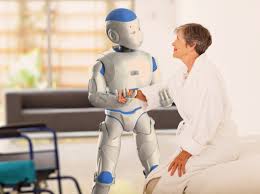
Romeo is a humanoid robot from Aldebaran robotics which is intended to be a genuine personal assistant and companion.
This research is now being used to validate the possible service uses for a larger robot than Nao and to test new technologies for possible integration in future products.
Specifications:
Height : 39cm
Weight : 7.5kg
Compatible os : Linux, windows, Mac
Connectivity : Ethernet, Wi-Fi
The tested process in the innovations includes human-robot interaction, moving eyes and the vestibular system, force controlled, etc.
